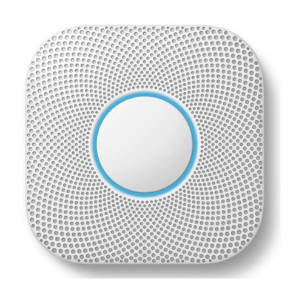Residential fires cause approximately 50 deaths each year in Australia, and that's to say nothing of the dozens of lives lost in recent bushfire events. If you have smoke detectors in your home, you’ll have a better chance of getting everyone out safely. While any smoke detector is better than none, here are a few things to look for when buying a new smoke alarm.
What to look for in a smoke detector
What to consider when buying a smoke detector
Multifunctional
The best smoke alarms can detect smoke particles, flames, and carbon monoxide. A multifunctional alarm can save you battery life or energy from your house for hard-wired smoke detectors. Combination smoke, fire, and carbon monoxide detectors are easier than ever to find.
Our favourite is the Google Nest Protect. There's both a wired and a battery-powered version, but both can detect smoke and carbon dioxide. It's also compatible with Google Nest, so you can silence false alarms (like when your partner burns their toast!) from your phone.
Smart
While classic ionisation and photoelectric smoke detectors are helpful, smart smoke detectors are at the cutting edge in fire safety. They communicate through apps and deliver alerts to your phone or other mobile devices if an alarm sounds.
Smart alarms can talk to each other too, so you’ll know exactly where the fire is when an alarm is triggered. The only downside is that smart devices are more expensive.
Backup power
If your home's power goes out, you still need to know if there's a fire or smoke emergency. Hard-wired smoke detectors need to have a battery backup or some other backup power source to keep them running.
If the power goes out, it takes your smoke detector with it. Battery powered smoke detectors should have a test button or chirp when the battery starts to drain.
If you or someone in your family experiences hearing loss or deafness, a wire-in strobe light can help. These devices connect with your existing smoke and fire alarms. When the smoke detector senses danger and sounds the alarm, the strobe light will flash to signal trouble.
Video: What Else Sets Off Smoke Alarms?
Subscribe to our YouTube channel and learn how to protect your home, loved ones, and belongings.
Types of smoke detectors
Smoke alarms typically have three types of sensors: ionisation, photoelectric, and dual. Here are the main differences between the three.
Photoelectric
Photoelectric smoke alarm sensors use light to detect smoke. When smoke particles are suspended in the air (as with a smoldering fire) the particles scatter the beam of light in the sensory chamber, which sets off the alarm.
Ionisation
Ionisation smoke detectors use radiation and an ionisation chamber to detect smoke. The ionising radiation helps detect small amounts of smoke in the air, as with a flaming fire. When smoke enters the sensor chamber, the current of the ionising radiation is disrupted, which triggers the alarm.
Dual sensors
Dual sensors include both photoelectric and ionisation sensors. These are considered the safest smoke and fire detection devices. Because they detect both flaming fires and smaller, smouldering fires, it’s unlikely that any fire-related danger will get past these double-duty sensors.
Smoke detector installation and maintenance
Smoke alarms can save a life, but they have to be properly installed and maintained. Don’t risk your family’s safety—use these tips to keep your smoke detector alarm in tip-top shape.
Check batteries: Dead batteries are a major factor in smoke alarm failures. A smoke detector won’t do you any good if it isn’t working, so make sure to check your batteries every month and use the “test“ button intermittently to ensure proper function.
Arm every level: Only New South Wales and Queensland legally require homes to have smoke detectors on every level, but it's a smart idea for all Australians. You could go one further and place an alarm in every bedroom, outside every sleeping area, and in your garage. On floors without bedrooms, install alarms in the living area or near stairways.
If you have a large home, consider adding even more to cover the whole footprint.
Mount high: Smoke rises. It’s important to put your smoke detectors within a foot of your ceilings and 10 feet from cooking areas.
For vaulted ceilings, avoid putting smoke detectors in the “pitch” of the roofline. Instead, mount fire alarms about one metre below the ceiling so they can accurately read smoke.
Never run out of batteries: Keep several spare batteries in storage at all times, and replenish often. That way, you’ll always be ready to replace a dead battery in your smoke alarm. It's not a bad idea to set a recurring reminder on your phone to check the batteries each month.
Keep it clean: Dirt and debris interfere with the sensors on your smoke alarm. Dusty buildup can lead to false alarms or delayed detection during an emergency. Whether you have a photoelectric alarm or an ionisation detector, regular cleaning will keep your smoke alarm in working order.
Dodge drafts: Keep smoke alarms away from windows, doors, and air ducts. Drafts can disrupt the operation of smoke detectors and increase the occurrence of nuisance alarms.
Get connected: Wired and wireless interconnected smoke alarms help ensure everyone in your home knows about the emergency. You can install the connection easily and it will sound the siren throughout the house using each of your fire alarms. It takes a few extra steps to set up and test, but it means family members in every room will get the warning.
Final word
Even though it's on the expensive side, we picked the Google Nest Protect as the best smoke detector because it's just so damn helpful. Beyond being able to detect carbon monoxide and different types of fires, the app removes the frustration that comes with typical fire alarms.
Still, any smoke alarm is better than none, so don't hesitate to stock up.
Smoke detector FAQ
If your smoke detector is beeping regularly, it could be because the batteries are running low.
Try changing the batteries first. If the beeping continues, the device may be sending false alarms. Make sure it's far enough from the bathroom or stove to avoid sensing heat or steam any time you use the room.
There are pros and cons to smart smoke detectors, but it boils down to your preference and budget.
Smart smoke detectors connect to your phone, allowing you to know when the alarm sounds when you aren’t home. But these aren’t totally fool proof either. They’re connected to your Wi-Fi, so if your internet connection drops, you may be without protection.
For the best results, we recommend testing your smoke detectors once a month. You’ll always be ready for an emergency and this will prevent false alarms and beeping from drained batteries.
You should have at least one smoke detector per floor and outside of each of your sleeping areas.
Smoke and fire detectors warn you when an emergency happens, but how do you prevent a fire in the first place?
Start with a few common safety practices like careful cooking, cleaning out lint traps frequently, and storing flammable products safely. It's also a good idea to keep a fire extinguisher on hand in the house and show everyone how to use it.

